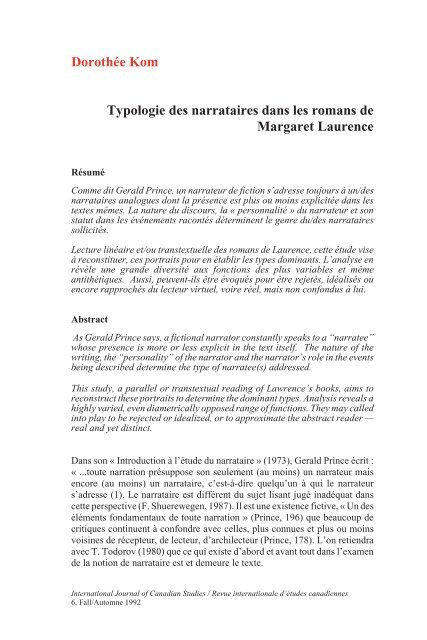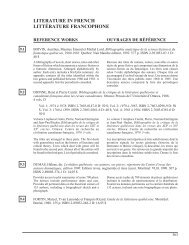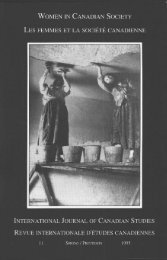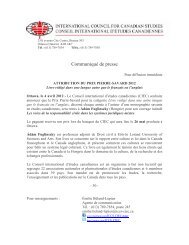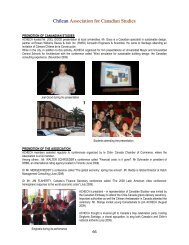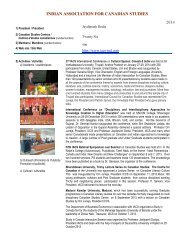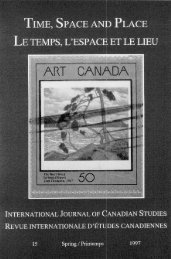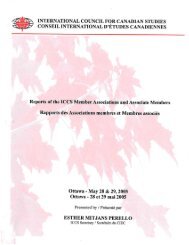Arts and Literature in Canada:Views from Abroad, Les arts et la ...
Arts and Literature in Canada:Views from Abroad, Les arts et la ...
Arts and Literature in Canada:Views from Abroad, Les arts et la ...
- No tags were found...
Create successful ePaper yourself
Turn your PDF publications into a flip-book with our unique Google optimized e-Paper software.
Dorothée KomTypologie des narrataires dans les romans deMargar<strong>et</strong> LaurenceRésuméComme dit Gerald Pr<strong>in</strong>ce, un narrateur de fiction s’adresse toujours à un/desnarrataires analogues dont <strong>la</strong> présence est plus ou mo<strong>in</strong>s explicitée dans lestextes mêmes. La nature du discours, <strong>la</strong> « personnalité » du narrateur <strong>et</strong> sonstatut dans les événements racontés déterm<strong>in</strong>ent le genre du/des narratairessollicités.Lecture l<strong>in</strong>éaire <strong>et</strong>/ou transtextuelle des romans de Laurence, c<strong>et</strong>te étude viseà reconstituer, ces portraits pour en établir les types dom<strong>in</strong>ants. L’analyse enrévèle une gr<strong>and</strong>e diversité aux fonctions des plus variables <strong>et</strong> mêmeantithétiques. Aussi, peuvent-ils être évoqués pour être rej<strong>et</strong>és, idéalisés ouencore rapprochés du lecteur virtuel, voire réel, mais non confondus à lui.AbstractAs Gerald Pr<strong>in</strong>ce says, a fictional narrator constantly speaks to a “narratee”whose presence is more or less explicit <strong>in</strong> the text itself. The nature of thewrit<strong>in</strong>g, the “personality” of the narrator <strong>and</strong> the narrator’s role <strong>in</strong> the eventsbe<strong>in</strong>g described d<strong>et</strong>erm<strong>in</strong>e the type of narratee(s) addressed.This study, a parallel or transtextual read<strong>in</strong>g of Lawrence’s books, aims toreconstruct these portraits to d<strong>et</strong>erm<strong>in</strong>e the dom<strong>in</strong>ant types. Analysis reveals ahighly varied, even diam<strong>et</strong>rically opposed range of functions. They may called<strong>in</strong>to p<strong>la</strong>y to be rejected or idealized, or to approximate the abstract reader —real <strong>and</strong> y<strong>et</strong> dist<strong>in</strong>ct.Dans son « Introduction à l’étude du narrataire » (1973), Gerald Pr<strong>in</strong>ce écrit :« ...toute narration présuppose son seulement (au mo<strong>in</strong>s) un narrateur maisencore (au mo<strong>in</strong>s) un narrataire, c’est-à-dire quelqu’un à qui le narrateurs’adresse (1). Le narrataire est différent du suj<strong>et</strong> lisant jugé <strong>in</strong>adéquat dansc<strong>et</strong>te perspective (F. Shuerewegen, 1987). Il est une existence fictive, « Un deséléments fondamentaux de toute narration » (Pr<strong>in</strong>ce, 196) que beaucoup decritiques cont<strong>in</strong>uent à confondre avec celles, plus connues <strong>et</strong> plus ou mo<strong>in</strong>svois<strong>in</strong>es de récepteur, de lecteur, d’archilecteur (Pr<strong>in</strong>ce, 178). L’on r<strong>et</strong>iendraavec T. Todorov (1980) que ce qui existe d’abord <strong>et</strong> avant tout dans l’examende <strong>la</strong> notion de narrataire est <strong>et</strong> demeure le texte.International Journal of Canadian Studies / Revue <strong>in</strong>ternationale d’études canadiennes6, Fall/Automne 1992


